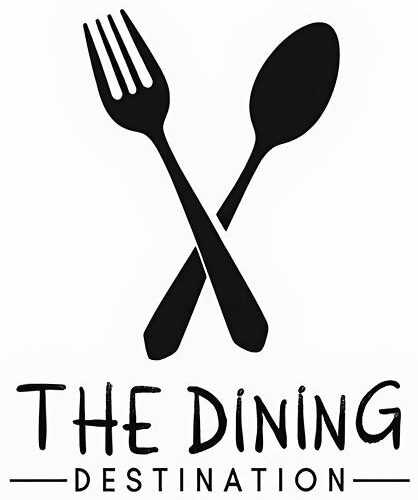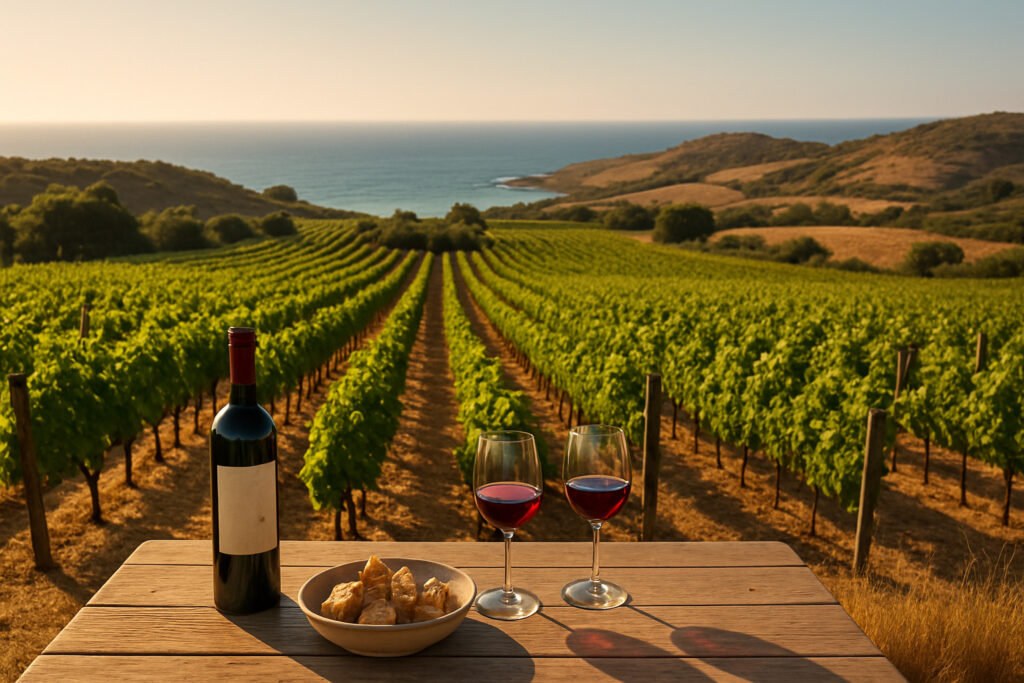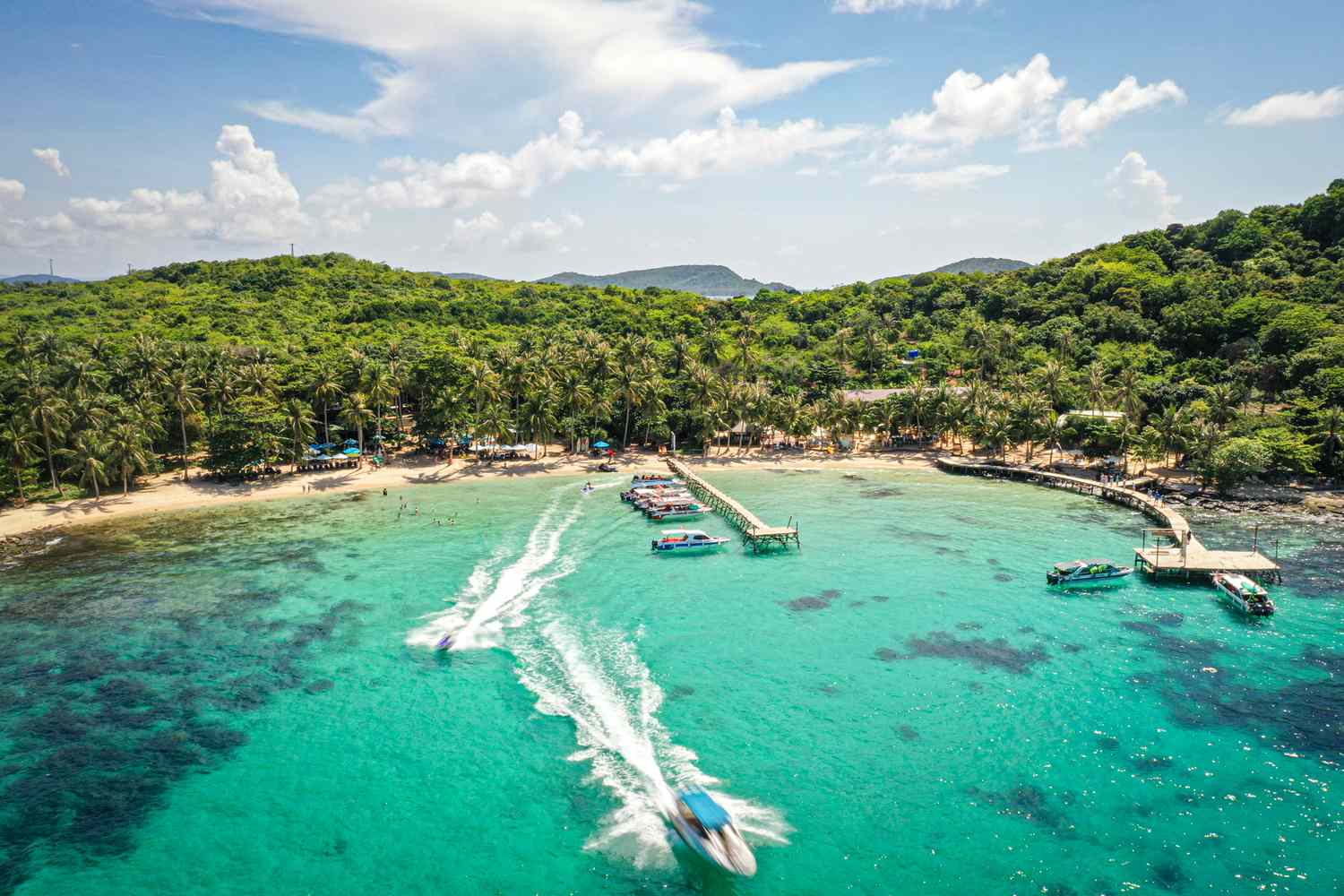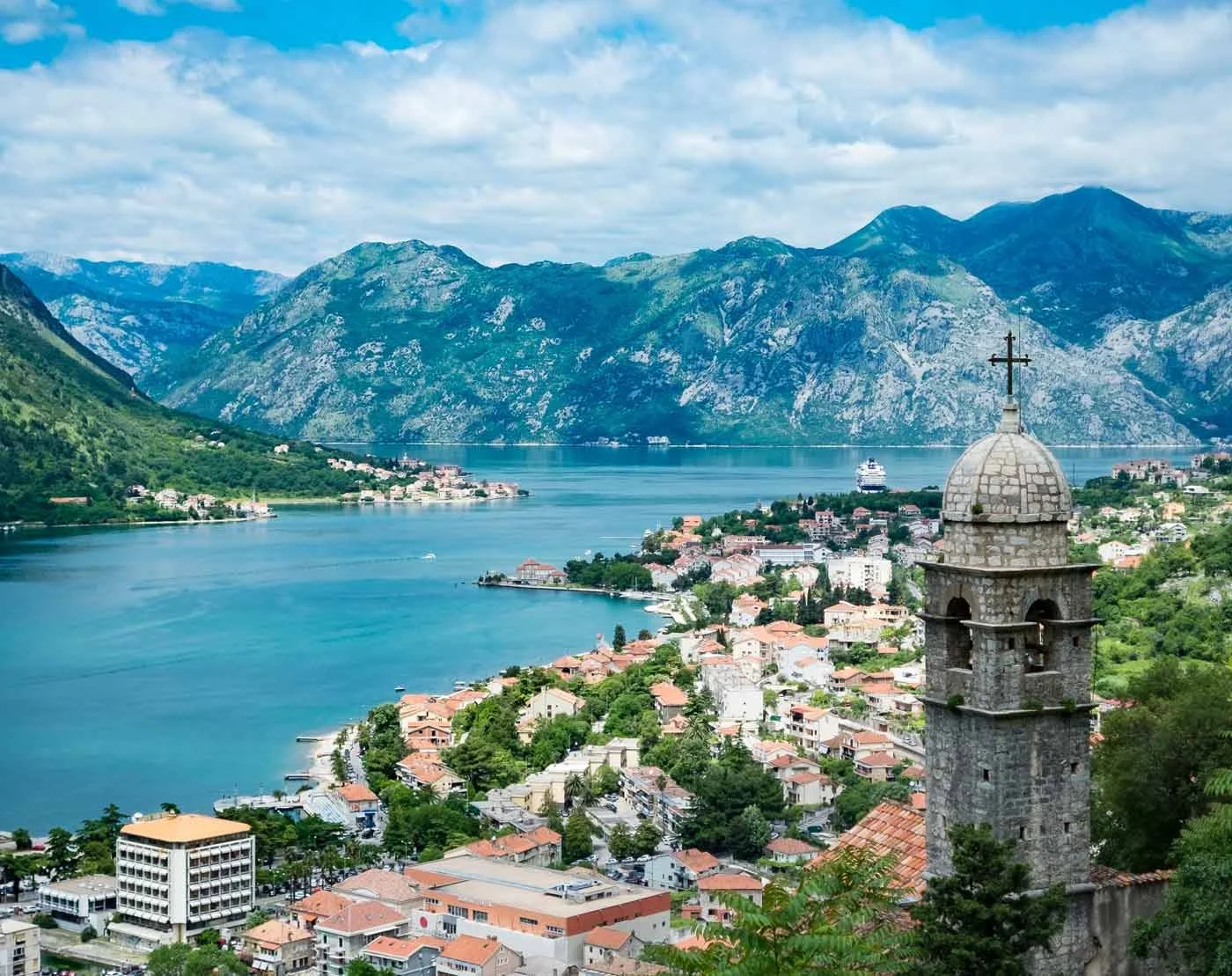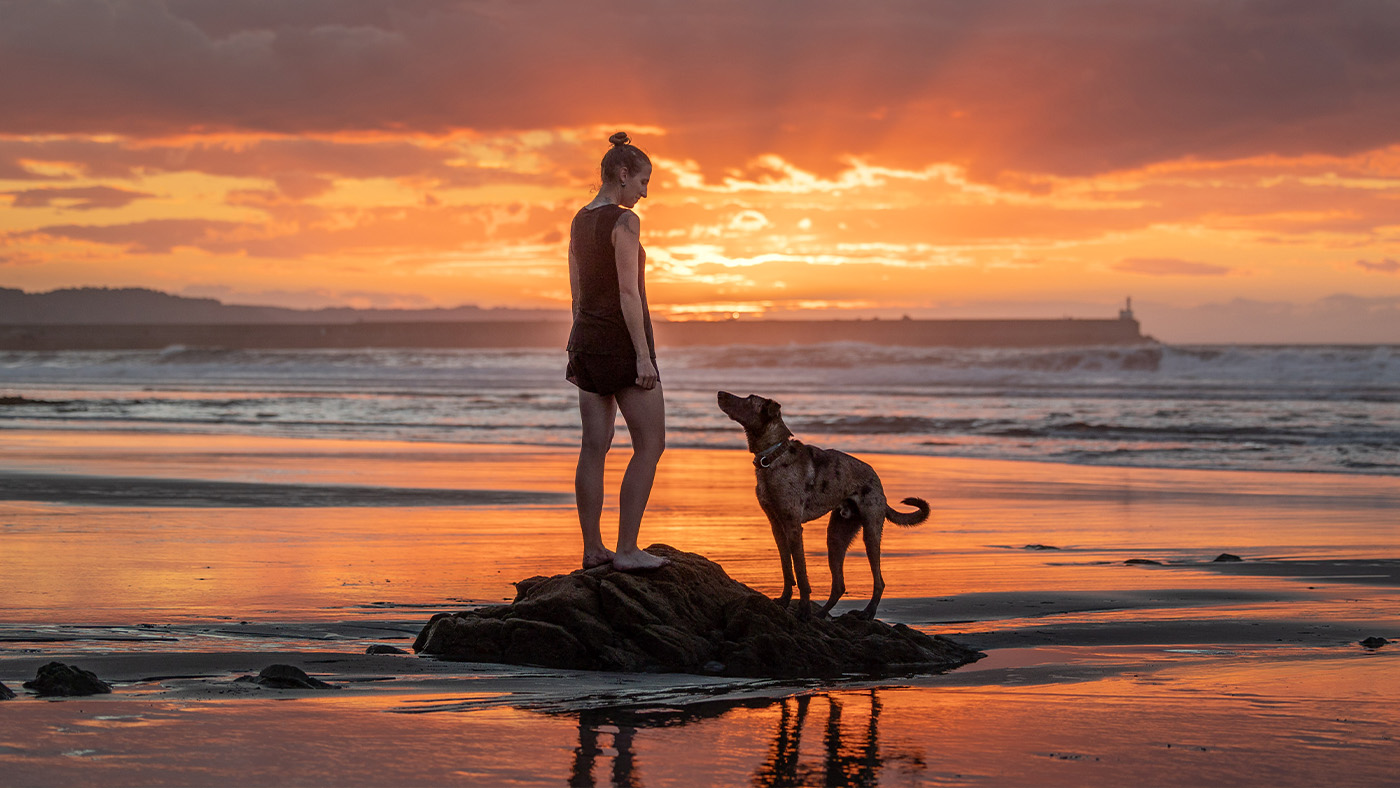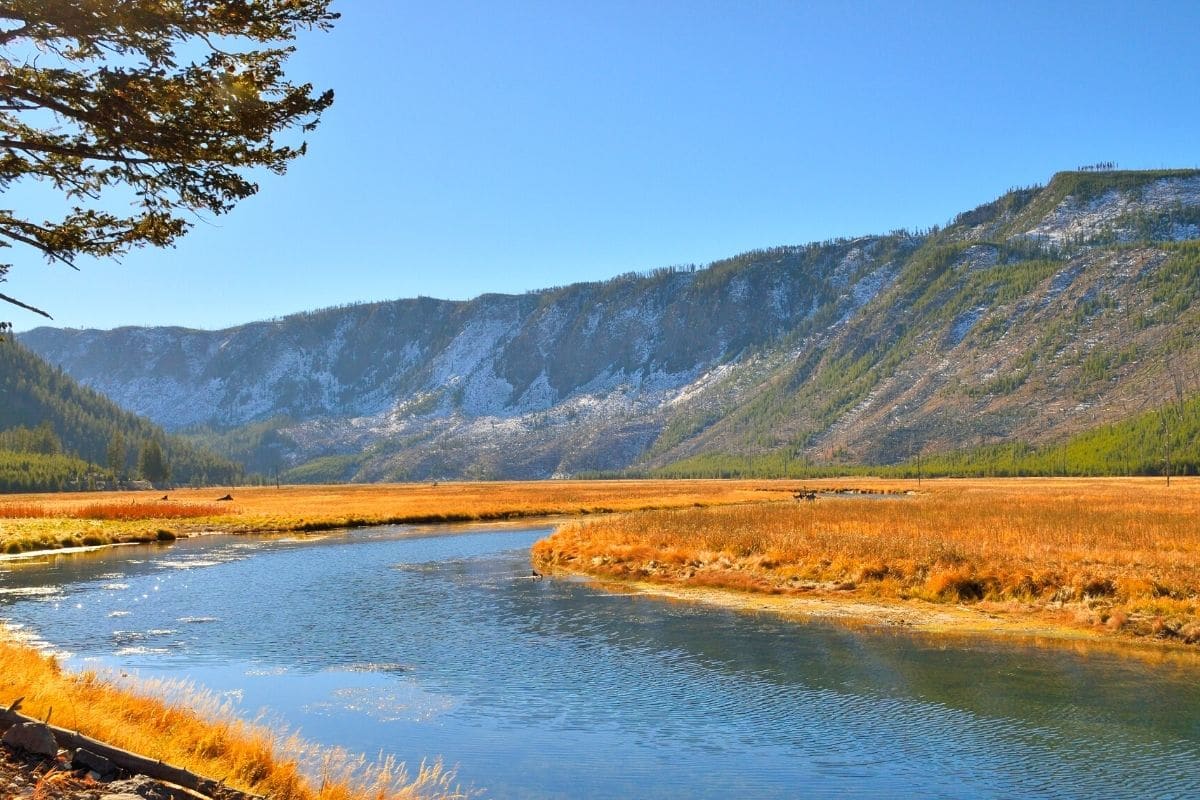Algarve – Portugal’s Sun-Drenched Wine Frontier
Algarve wine tasting invites you into Portugal’s sunniest wine region, where Mediterranean flavors dance with Atlantic influences against a backdrop of breathtaking coastal beauty. Curated by our New York–based editors at The Dining Destination, this guide uncorks the best of the Algarve for traveling oenophiles.
Quick Guide to Algarve Wine Tasting
What to Know Details Best Wineries Morgado Do Quintão (4.8/5), Quinta Dos Sentidos (5.0/5), Quinta Da Tôr (4.8/5) Average Cost €55 per tasting (range: €20-€135) Best Time to Visit Year-round (300 days of sunshine), harvest season (late July-Sept) Wine Regions Four DOCs: Lagos, Portimão, Lagoa, and Tavira Key Grape Varieties Reds: Negra Mole, Trincadeira, Castelão; Whites: Arinto, Siria, Malvasia Fina
When Roman legions first reached the southwestern edge of the Algarve, they believed they’d finded the end of the world. Yet even here, at what felt like the edge of existence, they planted vines – establishing a winemaking tradition that still flourishes today. Despite welcoming five million visitors yearly, the Algarve’s vibrant wine scene remains one of Portugal’s most delightful secrets.
Bathed in roughly 3,000 hours of glorious sunshine annually, this region boasts a truly special terroir. The unique combination of sandy loam, limestone, and clay soils of the barrocal inland area, kissed by cooling Atlantic breezes, creates wines with distinctive character that are increasingly turning heads internationally. Today, more than 30 welcoming wine estates (with some counts approaching 50) open their doors for visitors seeking authentic tasting experiences.
“In a land deeply rooted in wine-growing traditions, artisanal viticulture is re-emerging,” as one local winemaker told me, with indigenous varieties like Negra Mole finding their rightful place alongside international grapes in award-winning blends. The region’s Touriga Nacional delivers bold reds with remarkable depth, while the crisp Síria grape produces whites of surprising complexity.
This modern renaissance builds upon ancient Roman foundations, creating wines that perfectly capture the Algarve’s unique position between Mediterranean warmth and Atlantic freshness. Whether you’re in the mood for a simple vineyard tasting, an interactive blending workshop where you create your own bottle, or a full-day trip combining wine with hilltop dining, the Algarve caters to every wine lover’s dream – regardless of your experience level or budget.

The region’s four DOC (Denominação de Origem Controlada) areas – Lagos, Portimão, Lagoa, and Tavira – each offer their own expression of the Algarve’s terroir, with scientific research on regional terroir revealing fascinating insights into how these diverse microclimates influence the final glass. From the western vineyards with their stronger Atlantic influence to the slightly warmer eastern slopes, each area produces wines worth finding on your Portuguese trip.
Algarve – Portugal’s Sun-Drenched Wine Frontier
While wine lovers often swoon over Port from the Douro Valley or crisp Vinho Verde from the north, Portugal has been hiding a sun-kissed secret at its southernmost tip. The Algarve wine tasting scene is quietly blooming into something truly special – a place where ancient traditions meet modern innovation under 300 days of glorious sunshine.
The Algarve doesn’t just have one wine personality but four distinct ones, divided into Denominação de Origem Controlada (DOC) areas: Lagos, Portimão, Lagoa, and Tavira. Each tells its own story through the glass. Inland, the barrocal zone’s complex soils – a fascinating mix of sand, limestone, clay, shale, and alluvium – force vines to dig deep in their quest for water, resulting in wines with remarkable concentration and character.
“If you love finding new wine regions, the Algarve is a destination I could not more highly recommend,” confesses one wine journalist who explored the area. “This still off-the-radar winemaking region is the perfect destination for discerning wine lovers.”
What makes this region truly magical is its climate sweet spot. Those endless sunny days (around 300 annually) combine with cooling Atlantic breezes to create nature’s perfect wine lab – warm enough for full ripening but fresh enough to maintain that crucial acidity that gives wines their vibrancy.
Indigenous Treasures and International Varieties
The Algarve’s vineyards are like a fascinating family reunion where local characters mingle with international guests. Leading the local lineup is Negra Mole, the region’s signature red grape that produces wines with soft tannins and bright red fruit flavors that seem to capture the region’s sunny disposition in liquid form.
Other Portuguese natives making their mark include Castelão with its structured red fruit notes, Trincadeira contributing delightful spice and herbal qualities, and the noble Touriga Nacional adding impressive depth to blends.
On the white side, Síria (sometimes called Crato Branco) brings citrus and floral notes that practically sing of Mediterranean sunshine, while Arinto contributes that mouth-watering acidity and minerality that makes you crave seafood. The aromatic richness of Malvasia Fina rounds out the local white grape portfolio.
Many winemakers blend these indigenous varieties with international grapes like Syrah, Cabernet Sauvignon, and Alvarinho, creating wines that feel both distinctly Portuguese and internationally appealing – the best of both worlds in a glass.
From Ancient Roots to Modern Renaissance
When Romans planted vines here centuries ago, little did they know they were starting something that would endure through the ages. After periods of decline, the Algarve has experienced a remarkable wine renaissance since 2000. Today, over 50 producers craft wines that are turning heads at national and international competitions.
The region’s classification as Vinho Regional (VR) Algarve gives winemakers room to experiment beyond strict DOC regulations – freedom that has sparked innovation while maintaining that crucial sense of place. It’s this balance of respecting the past while embracing the future that makes Algarve wine tasting so exciting.
As one passionate winemaker from Quinta da Tôr puts it, “We’re bringing ancient traditions into the present, using modern knowledge to express our unique terroir while honoring the methods passed down through generations.”
This beautiful marriage of old and new, of sun and sea, of traditional and innovative – that’s what makes finding Algarve wines feel like finding hidden treasure in plain sight. According to scientific research on regional terroir, it’s this unique combination of factors that gives Algarve wines their distinctive personality.

Algarve Wine Tasting Essentials
Planning your Algarve wine tasting trip? Let me walk you through what makes these experiences so special. Most wineries here offer beautifully structured tastings where you’ll sample their signature wines while knowledgeable hosts share stories about local winemaking traditions, grape varieties, and tasting notes to improve your appreciation.
Price-wise, you can expect to pay around €55 per person on average, though options range widely. Budget-friendly tastings start at just €20 for a simple flight of three wines, while comprehensive full-day experiences featuring tours, multiple tastings, workshops, and meals might run up to €135. A lovely bonus: many estates let you purchase bottles directly from their cellars, often at better prices than you’ll find in retail shops.
Your experience typically begins with a stroll through sun-drenched vineyards and a peek into production facilities. Here, you’ll find how the unique Algarve terroir influences everything from grape growing to bottling. Then comes the best part – settling in for a guided tasting, often accompanied by delicious local treats like regional cheeses, cured meats, or traditional sweets that bring out the best in each wine.
| Wine Style | Characteristics | Key Varieties | Food Pairings |
|---|---|---|---|
| White | Crisp, aromatic with citrus, stone fruit, and floral notes; medium body with refreshing acidity | Arinto, Síria, Malvasia Fina | Fresh seafood, grilled fish, light salads |
| Red | Medium to full-bodied with red fruit, spice, and sometimes herbal notes; moderate tannins | Negra Mole, Castelão, Touriga Nacional | Iberian pork dishes, game meats, rich stews |
| Rosé | Vibrant with red berry flavors, floral notes, and refreshing acidity | Negra Mole, Aragonês | Cataplana (seafood stew), grilled chicken, paella |
| Sparkling | Neat with fine bubbles, citrus and apple notes, and crisp finish | Arinto, Síria | Aperitifs, oysters, light appetizers |
| Fortified | Rich, sweet with dried fruit, nuts, and caramel notes | Various | Regional desserts, blue cheeses |
What Makes “Algarve Wine Tasting” Special?
The magic of an Algarve wine tasting lies in its intimate, personal nature. Unlike the commercial operations you might find in more famous wine regions, many Algarve estates are family affairs where owners themselves might pour your wine and share generations of winemaking wisdom. These personal connections create memories that last far longer than the lingering finish of their wines.
You can literally taste the ocean in many Algarve wines – particularly the whites and rosés, which often carry a subtle salinity that makes them perfect partners for the region’s incredible seafood. The coastal sandy loam soils contribute distinctive minerality, while clay and limestone-rich soils further inland give structure and depth to the reds.
As one passionate local winemaker told me with a smile, “We’re blessed with around 300 days of sunshine – perfect for ripening grapes. But it’s the Atlantic breezes that give our wines their soul, cooling the vines and adding that refreshing quality that balances our abundant sunshine.”
Small-batch production is the norm here, not the exception. Most Algarve wineries focus on crafting limited quantities with extraordinary care rather than mass-producing commercial wines. This dedication to quality over quantity shows in every glass – these are wines made with heart.
Typical “Algarve Wine Tasting” Flight
When you sit down for an Algarve wine tasting, expect a journey through 3-5 distinctive wines, though premium experiences might include more. Your tasting flight typically unfolds like this:
You’ll start with a welcoming sip – often a crisp, refreshing white or sparkling wine that awakens your palate. Next comes the signature white, usually showcasing indigenous treasures like Síria or Arinto with their bright, citrusy profiles. The rosé follows, demonstrating how local red grapes transform into something completely different when crafted in this lighter style.
For the reds, you’ll typically taste a younger, fruit-forward expression first – perhaps featuring the region’s signature Negra Mole with its soft tannins and bright red fruit character. The grand finale is often a reserve red showing how oak aging and thoughtful blending of native and international varieties creates wines of remarkable complexity.
Many wineries offer the special treat of barrel tasting, where you can sample wines still evolving in oak – a fascinating behind-the-scenes glimpse into how time works its magic. Your host might even dip a glass “thief” into the barrel right before your eyes, offering a preview of wines that won’t be bottled for months or years.
As a lovely memento, most tastings include a souvenir glass to take home, or the option to purchase one. Even better, many estates offer exclusive bottles available only at the winery – perfect treasures to bring back for wine-loving friends or to savor later as you reminisce about your Algarve trips.

Planning Your Algarve Wine Route
Creating the perfect Algarve wine tasting itinerary requires some planning, as most wineries are located inland from the popular coastal resorts. The good news is that the region is relatively compact, with most wineries within a 30-60 minute drive of one another, making it possible to visit several in a single day.
Self-Drive Trips
Renting a car offers the most flexibility for exploring the Algarve wine country. Most wineries are concentrated in the central Algarve, particularly around the towns of Silves, Lagoa, and Algoz, with others scattered throughout the region from Lagos in the west to Tavira in the east.
A word of caution from experienced visitors: “Many Algarve wineries aren’t on GPS—Google Maps offline works better,” notes one wine blogger. Download maps before your trip, as cellular service can be spotty in rural areas.
A popular route begins in Lagos, heading inland to Silves (the historical heart of Algarve wine production), then eastward through Lagoa and Albufeira before ending in Tavira. This loop covers all four DOC regions and can be completed over 2-3 days for a comprehensive experience.
Top Wineries to Visit
Based on visitor reviews and wine quality, these wineries consistently rank among the best in the Algarve:
-
Morgado do Quintão (4.8/5 stars) – Located near Lagoa, this historic estate features centuries-old vines and offers tastings under a 2,000-year-old olive tree. Their focus on indigenous varieties and organic farming makes this a must-visit for authenticity seekers.
-
Quinta dos Sentidos (5.0/5 stars) – This boutique winery near Silves offers personalized tastings and an immersive experience including vineyard walks and barrel sampling. Their small-batch approach showcases the potential of both native and international varieties.
-
Quinta da Tôr (4.8/5 stars) – Situated near Loulé, this family-run estate offers poolside tastings with stunning views. Their award-winning wines include exceptional examples of Negra Mole and impressive Syrah (some reaching 17% alcohol while maintaining balance).
-
Quinta dos Vales (4.7/5 stars) – This innovative estate near Lagoa offers the unique “Winemaker Experience,” allowing visitors to rent a vineyard parcel and create their own custom wine blend. Their art-filled grounds and accommodation options make this ideal for an extended stay.
-
Cabrita Wines (4.6/5 stars) – Located near Silves, this modern winery focuses on expressing the unique terroir of the Algarve through both indigenous and international varieties. Their guided tastings include excellent food pairings with local products.
Guided Tours: A Worry-Free Alternative
If you prefer not to drive or want deeper insights into the region, guided tours are an excellent option. Companies like Algarve Views and Algarving Tours offer half-day and full-day excursions that include transportation, multiple winery visits, and often lunch at a local restaurant.
“With us, safety comes first. This way you can truly enjoy the freeing trip tour of Algarve,” explains one tour operator. These experiences typically cost between €80-150 per person and can be customized to focus on specific types of wines or include additional activities like olive oil tastings or cultural visits.
A particularly popular option is the mountain-top wine tour, which combines visits to two wineries with lunch at a panoramic restaurant in the Monchique mountains, offering breathtaking views over the entire region.
Transportation Tips
For those not driving, here are some alternatives:
- Train: The regional train line runs along the coast with stations in major towns. From there, you’ll need to take a taxi to reach most wineries.
- Uber/Taxi: Available in larger towns and can be arranged for winery visits, though costs can add up for longer distances.
- Bicycle: Some coastal areas offer bike rentals, which can be suitable for visiting nearby wineries, particularly around Lagos and Lagoa.
Whatever your transportation choice, advance reservations are essential for most wineries, especially during high season (June-August) and for larger groups.

Best Times & Immersive Experiences
While the Algarve’s 300 days of sunshine make wine tasting possible year-round, certain times offer unique advantages for visitors seeking the most authentic experiences.
Seasonal Highlights
-
Harvest Season (Late July to September): Experience the excitement of harvest, with some estates allowing visitors to participate in grape picking or traditional foot-treading. “Early September is a good time to catch the harvest,” advises a local wine expert. The energy and activity during this period provide insights into winemaking that aren’t available at other times.
-
Spring (April to June): Witness vineyards coming to life with new growth against a backdrop of wildflowers. The moderate temperatures and smaller crowds make this an ideal time for leisurely wine tours and outdoor tastings.
-
Autumn (October to November): Enjoy the changing colors of the vineyards and the relaxed pace after harvest. Many winemakers have more time for in-depth discussions during this period, and you might get the chance to taste newly fermented wines.
-
Winter (December to March): Though some smaller wineries reduce their hours, winter offers the most intimate experiences with winemakers who have time to share their passion. The occasional rainy day is perfect for cellar tours and extended tastings by the fireplace.
The shoulder seasons (April-June and September-October) generally offer the best combination of good weather, winemaking activity, and fewer tourists compared to the peak summer months.

Beyond Basic Tastings: Immersive Wine Experiences
For those seeking deeper engagement with Algarve wines, many estates offer specialized experiences that go beyond standard tastings:
-
Blending Workshops: Create your own custom wine blend under expert guidance. At Quinta dos Vales, the “Winemaker Experience” allows participants to blend, bottle, and cork their own wine to take home. As one visitor recounted, “I created a personal blend (40% Touriga Nacional, 40% Cabernet Sauvignon, 20% Aragonês) and hand-corked bottles for a special birthday.”
-
Vineyard Nights: Several estates host evening events combining wine, local cuisine, and entertainment under the stars. Quinta dos Capinhas offers “Vineyard Nights” during summer, featuring tastings, dinner, and live music among the vines.
-
Infinity-Pool Tastings: Combine relaxation with wine appreciation at estates like Quinta da Tôr, where you can enjoy their award-winning wines poolside with panoramic views of the surrounding countryside.
-
Jeep Safari Wine Tours: Trip companies like Extremo Ambiente offer off-road excursions into the Monchique mountains combined with winery visits and tastings at estates like Vila Sodré.
-
Cooking Workshops: Learn to prepare traditional Algarve dishes paired with local wines. Morgado do Quintão offers cooking workshops where visitors learn regional recipes using estate-grown ingredients, followed by a meal paired with their wines.
-
Stay Among the Vines: Several wineries offer on-site accommodation, allowing for a fully immersive experience. Quinta dos Capinhas features three villas built within their working vineyard, while Morgado do Quintão offers renovated farm cottages dating back centuries.
These specialized experiences typically require advance booking and range from €50-200 per person depending on the duration and inclusions.
Pairing Algarve Wines with Local Flavours
There’s something magical about enjoying Algarve wine tasting alongside the region’s traditional dishes. This sun-drenched corner of Portugal offers a delicious marriage of flavors that tells the story of both land and sea, creating food and wine combinations that feel like they were destined to be together.
“We pride ourselves in combining both our love for local wine with our region’s scenic views to give you a memorable feel and experience,” explains an Algarve tour guide with a warm smile. “There is nothing more amazing than engaging in wine tasting and exploring new places.”
Classic Algarve Food and Wine Pairings
The coastal bounty of the Algarve shines brilliantly when paired with the region’s crisp white wines. Imagine sitting at a seaside restaurant as a copper cataplana is opened before you, releasing aromatic steam from a seafood stew that’s been simmering with clams, prawns, and local fish. A glass of Arinto beside it offers the perfect counterpoint – its bright acidity and citrus notes cutting through the richness of the dish.
During summer months, the smell of grilled sardines fills the air at beachside restaurants. These simple but flavorful fish find their perfect match in a glass of Síria, whose subtle mineral character and hint of salinity complement rather than compete with the fish’s natural flavors.
For a truly luxurious experience, the oysters harvested from the Ria Formosa lagoon system taste like the ocean itself. Pair them with a locally-grown Alvarinho, whose vibrant fruit and floral notes improve the briny freshness of each oyster.
Venture inland, and the cuisine shifts from sea to land. The famous piri-piri chicken – marinated in a spicy chili sauce before being grilled over open flames – finds balance with a cooling Castelão rosé. The wine’s red fruit flavors tame the heat while complementing the smoky char of the meat.
The prized Iberian black pork, raised on acorns in the northern hills of the region, offers rich, nutty flavors that stand up beautifully to a bold blend of Touriga Nacional and Syrah. These powerful reds provide fruit and spice notes that improve the meat’s natural sweetness.
Game meats feature prominently in traditional Algarve cooking, particularly in slow-cooked stews of rabbit or partridge. These earthy dishes find harmony with blends of Negra Mole and Trincadeira, whose herbal qualities and medium body complement rather than overwhelm the delicate game flavors.
The Algarve’s sweet tooth is satisfied by traditional desserts that pair surprisingly well with certain wines. Dom Rodrigo – a confection of egg yolks, sugar, and cinnamon wrapped in colorful foil – finds its match in a glass of honeyed Late Harvest Moscatel. The wine’s natural sweetness and citrus notes improve the dessert’s rich flavors.
Cured figs, a specialty of the region, offer concentrated sweetness that balances beautifully with aged fortified red wines. The complex, nutty character of these wines creates a memorable end to any meal.
For a refreshing contrast, try the dense, sweet almond cake (a Moorish influence still present in Algarve cuisine) with a glass of sparkling Brut. The crisp effervescence cleanses the palate between bites, creating a delightful textural play.
Many wineries and local restaurants offer specialized pairing menus showcasing these classic combinations. At Restaurante Veneza, visitors can enjoy a multi-course meal with paired wines from various Algarve producers, providing a comprehensive taste tour without changing locations.
“It was among the most excellent of the local Algarve wines I’ve tasted during my visit,” remarks one visitor about a pairing experience, eyes lighting up at the memory. “The combination of fresh seafood with the region’s crisp whites created a perfect harmony of flavors.”
For those wanting to deepen their understanding of why certain foods and wines work so well together, several wineries offer specialized workshops. At Quinta do Frances near Silves, visitors can participate in guided tastings that include pairing principles and hands-on exercises with different food elements – a delicious way to educate your palate.

Frequently Asked Questions about Algarve Wine Tasting
How much does an Algarve wine tasting cost on average?
When planning your Algarve wine tasting trip, you’ll find experiences to suit every budget. The typical tasting will cost around €55 per person, though prices vary widely depending on what you’re looking for.
If you’re watching your euros, many wineries offer basic tastings of 3-5 wines starting at just €20-25. For something more comprehensive with vineyard tours, extended tastings, and delicious local food pairings, expect to pay between €50-80 per person.
“We tailor our experiences to match different preferences and budgets,” explains one winery owner. “Some visitors want a quick introduction to our wines, while others prefer to spend half a day immersed in the full experience.”
For the ultimate wine trip, full-day experiences combining multiple wineries with meals and transportation typically range from €100-135. The silver lining? Algarve wine experiences generally offer exceptional value compared to more famous European wine regions, with many visitors pleasantly surprised by the generous pours and personal attention.
Do I need to book winery visits in advance?
Yes, advance booking is definitely recommended for your Algarve wine tasting experiences, especially if you’re visiting between June and September. Many of the region’s most charming wineries are small, family-run operations with limited staff and tasting space. Booking ahead ensures they can prepare properly for your visit.
Most wineries make booking easy through email, phone, or their websites. For popular estates like Morgado do Quintão and Quinta dos Vales, try to book at least a week ahead during summer. In winter, you might get away with same-day or next-day reservations, but a quick call ahead is still wise.
As one visitor noted, “We tried to visit three wineries without reservations and were turned away from two. The third squeezed us in but couldn’t offer their full experience. Lesson learned!”
If you’re looking at guided tours covering multiple wineries, booking 2-3 days in advance is typically sufficient in quieter months, though popular summer tours can fill up weeks ahead.
Are Algarve wines available outside Portugal?
Finding Algarve wines beyond Portugal’s borders can be a bit of a treasure hunt. Only a handful of producers currently export, and their distribution is limited to select international markets. This is part of what makes Algarve wine tasting so special – you’re experiencing flavors that rarely travel far from their source.
Within Portugal, you’ll have better luck finding these wines in specialty shops and some supermarkets, particularly in Lisbon and Porto. Internationally, your best bet is high-end restaurants and boutique wine shops in major European cities or select locations in the United States.
“Our production is still relatively small,” explains one Algarve winemaker. “We prefer to focus on quality over quantity, which means we can’t supply large international markets yet.”
If you find a wine you absolutely love during your tasting trips, purchasing directly from the winery is often your best option. Many offer shipping services within the EU for larger orders, and some have wine club memberships that include periodic international shipments. Consider setting aside space in your luggage – these bottles make wonderful souvenirs that let you revisit your Algarve memories long after your trip ends.
What should I wear for wine tasting in the Algarve?
The Algarve accepts a relaxed, Mediterranean vibe that extends to its wineries. For most Algarve wine tasting experiences, comfortable casual attire is perfectly appropriate. You won’t find stuffy dress codes here – the focus is on enjoyment rather than formality.
That said, a few practical considerations will make your experience more comfortable:
Wear flat, sturdy shoes if your tour includes vineyard walks – those rows can get dusty or muddy depending on the season. Bring sun protection (hat, sunglasses, sunscreen) for outdoor tastings, as the Algarve sun is powerful even in spring and fall. Consider layers – temperatures can vary significantly between sunny vineyards and cool cellars, and evenings can be breezy even in summer months.
“I wore a nice sundress and sandals for our tasting at Quinta dos Vales,” shares one visitor, “but wished I’d brought a light cardigan for when we moved into the cellar portion of the tour!”
For upscale estates or tastings that include fine dining, smart-casual attire might be more appropriate, but even then, comfort should be your priority.
Is English widely spoken at Algarve wineries?
You’ll have no trouble communicating during your Algarve wine tasting trips. English is widely spoken throughout the region, including at wineries both large and small. As one of Portugal’s premier international tourism destinations, the Algarve has adapted to welcome visitors from around the world.
Most tasting room staff, tour guides, and winemakers speak good to excellent English, eager to share their passion for local wines with international guests. “Even when my questions got technical about fermentation techniques, the winemaker had no trouble explaining everything in detail,” reports one American visitor.
In smaller family-run wineries, you might occasionally encounter staff with more limited English skills, but they typically ensure someone with good language abilities is available for international visitors. Portuguese, German, and French are also commonly spoken at many estates, reflecting the diverse tourism base the region attracts.
The language of wine, after all, is universal – and the warm Portuguese hospitality needs no translation.
Conclusion
The Algarve’s wine scene represents one of Portugal’s most exciting yet underappreciated oenological treasures. From the historic vineyards of Lagoa to the innovative estates near Silves, the region offers a diverse mix of wine experiences that combine tradition, innovation, and the unmistakable character of this sun-drenched coastal region.
As we at The Dining Destination have finded through our exploration of global wine regions, the joy of Algarve wine tasting lies not just in the quality of the wines themselves, but in the complete sensory experience. It’s the warm smile of a third-generation winemaker pouring you a glass of their grandfather’s legacy. It’s the breathtaking moment when you stand among sun-dappled vines with the Atlantic shimmering on the horizon. It’s that perfect sip of crisp Arinto alongside just-caught seafood that makes you understand what people mean by “terroir.”
Whether you’re a seasoned wine enthusiast who can detect subtle notes of minerality or a curious novice who simply knows what tastes good, the Algarve welcomes you with accessible yet authentic experiences. The region’s combination of small-scale production, personal attention, and diverse wine styles ensures that every visitor leaves with new favorites and lasting memories.
As you plan your wine journey through this captivating region, keep these practical tips in mind: pack light for your tasting days, leaving room in your luggage for those special bottles you’ll want to bring home; designate a driver or book guided tours if you plan to visit multiple wineries; keep an open mind about indigenous varieties like Negra Mole that might become your new favorites; and support sustainable producers who are preserving the Algarve’s winemaking heritage while protecting its environment for future generations.
Most importantly, take notes as you go—not just on tasting sheets, but in a journal or on your phone. Capture not only the wines that delighted your palate but also the stories behind them, the people who made them, and the moments they created. These notes will be your most precious souvenirs when you’re back home, perhaps opening one of those special bottles you carried across the ocean.
The Algarve may have once been considered the end of the world by ancient Romans, but for today’s wine lovers, it represents a new frontier of findy—one where traditional methods meet modern innovation, creating wines of remarkable character and sense of place.
“We’re not just making wine,” as one passionate winemaker told us while gazing across her vineyard at sunset. “We’re bottling the essence of the Algarve—its sunshine, its sea breezes, its ancient soils. Each bottle tells our story.” We invite you to uncork that story for yourself on your next visit to Portugal’s sunniest wine region.
While the Algarve is far from our New York City headquarters, our team regularly travels to bring you authentic insights from the world’s most exciting culinary destinations. For more Algarve food-and-wine inspiration to help plan your trip, visit our comprehensive guide to culinary travel experiences.
